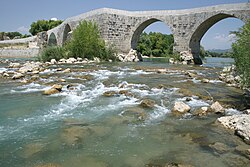
Back Evrimedon döyüşü Azerbaijani یوریمدون دؤیوشو AZB Битка при Евримедон (469/466 пр.н.е.) Bulgarian Batalla de l'Eurimedont Catalan Schlacht am Eurymedon German Μάχη του Ευρυμέδοντα Greek Batalla del Eurimedonte Spanish نبرد یوریمدون Persian Eurymedonin taistelu (466 eaa.) Finnish Bataille de l'Eurymédon French
| Battle of the Eurymedon | |||||||
|---|---|---|---|---|---|---|---|
| Part of the Wars of the Delian League | |||||||
 The Eurymedon River, near Aspendos | |||||||
| |||||||
| Belligerents | |||||||
| Delian League | Achaemenid Empire | ||||||
| Commanders and leaders | |||||||
| Cimon |
Tithraustes, Pherendatis † | ||||||
| Strength | |||||||
| 200 ships | 200–350 ships | ||||||
| Casualties and losses | |||||||
| Unknown | 200 ships destroyed | ||||||
Location of the Battle of the Eurymedon | |||||||
The Battle of the Eurymedon was a double battle, taking place both on water and land, between the Delian League of Athens and her Allies, and the Persian Empire of Xerxes I. It took place in either 469 or 466 BCE, in the vicinity of the mouth of the Eurymedon River (now the Köprüçay) in Pamphylia, Asia Minor. It forms part of the Wars of the Delian League, itself part of the larger Greco-Persian Wars.
The Delian League had been formed between Athens and many of the city-states of the Aegean to continue the war with Persia, which had begun with the first and second Persian invasions of Greece (492–490 and 480–479 BCE, respectively). In the aftermath of the Battles of Plataea and Mycale, which had ended the second invasion, the Greek Allies had taken the offensive, besieging the cities of Sestos and Byzantium. The Delian League then took over responsibility for the war, and continued to attack Persian bases in the Aegean throughout the next decade.
In either 469 or 466 BCE, the Persians began assembling a large army and navy for a major offensive against the Greeks. Gathering near the Eurymedon, it is possible that the expedition aimed to move up the coast of Asia Minor, capturing each city in turn. This would bring the Asiatic Greek regions back under Persian control, and give the Persians naval bases from which to launch further expeditions into the Aegean. Hearing of the Persian preparations, the Athenian general Cimon took 200 triremes and sailed to Phaselis in Pamphylia, which eventually agreed to join the Delian League. This effectively blocked the Persian strategy at its first objective.
Cimon then moved to pre-emptively attack the Persian forces near the Eurymedon. Sailing into the mouth of the river, Cimon quickly routed the Persian fleet gathered there. Most of the Persian fleet made landfall, and the sailors fled to the shelter of the Persian army. Cimon then landed the Greek marines and proceeded to attack the Persian army, which was also routed. The Greeks captured the Persian camp, taking many prisoners, and were able to destroy 200 beached Persian triremes. This stunning double victory seems to have greatly demoralised the Persians, and prevented any further Persian campaigning in the Aegean until at least 451 BCE. However, the Delian League do not appear to have pressed home their advantage, probably because of other events in the Greek world that required their attention.
